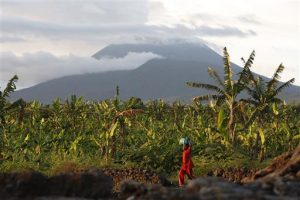
Hacking away in the midday sun, 49-year-old farmer Daniel Lazuba remembers vividly his life before one of Africa’s most active volcanos erupted 14 years ago.
“All of this was corn before,” he said as he pointed to rows of new banana trees pushing up between black stones. “My cabbage seems to be growing better than ever these days, but in this area, I still have to start from zero.”
Traumatized farmers like Lazuba are slowly returning to fields decimated by the 2002 eruption of Mount Nyiragongo in eastern Congo. Flowing lava flattened more than 30 percent of the city of Goma, 20 kilometers away. Nearly 150 people died, and 400,000 fled into neighboring Rwanda.
Now farmers returning to their fields find increased harvests from the rich volcanic soil, but there are signs that Nyiragongo will erupt again.
One farmer, Patrick Tamoini, said his harvests have risen over the past two harvests since he returned to his patch of land a short walk from the volcano’s base. The 41-year-old pockets more than $100 a month after taking care of family expenses, more than double his earnings before the eruption, he said. The average per capita monthly income in Congo is nearly $32 a month, according to the World Bank.
But returning to the fields wasn’t easy.
“The pain of what I lost kept me from coming back for such a long time,” Tamoini said. “With this level of production, I’m glad I finally did.”
The chemical makeup of volcanic soil makes for lucrative farming conditions, say researchers at the Goma Volcano Observatory.
“Lava actually enriches the soil that it initially burned,” said Mathieu Yalira, the chair of observatory’s geochemistry and environment department. Volcanic soil includes fertilizing elements such as iron, phosphorus and potassium, he said. In the years after an eruption, a process known as chemical weathering slowly makes lava soil more fertile than ordinary earth.
Local farmers didn’t seize on those benefits right away, observers say.
“Initially, no one was coming back because they were too devastated to see their burned fields,” said the chair of the observatory’s seismology department, Georges Mavonga. “But within the past year, visits toward the volcano have shown new villages in areas that were uninhabited before.”
He said the increase in lava soil farming may be a result of initial farmers seeing the benefits and spreading information to friends and family.
But the farmers should not get too attached to the newly fertile fields, warns the Rwanda Red Cross, which cared for many fleeing the 2002 eruption.
In February, an earthquake far beneath the surface caused rumbling noises near Virunga National Park, where the volcano is located. Since then, a new vent has appeared on the northeastern edge of the crater floor that shoots lava into the air every 30 seconds.
The Rwanda Red Cross has increased surveillance of the volcano in conjunction with the observatory.
“There are only presumptions about the next eruption, but people who study the daily life of this volcano tell us it could happen any day,” said Yves Riupi, a Red Cross crisis manager who works with seismologists at the Rwanda Natural Resources Authority.
The risk of another eruption is one that some farmers, whose lives depend on their crops, are now willing to take.
With vegetation growing more than six feet tall in some places with the rich volcanic soil, farmers say they want to keep working their fields, until the volcano erupts.
“If another one comes, who am I to stop it?” Lazuba asked. “There is nothing I can do.”
Note: The above post is reprinted from materials provided by The Associated Press.









